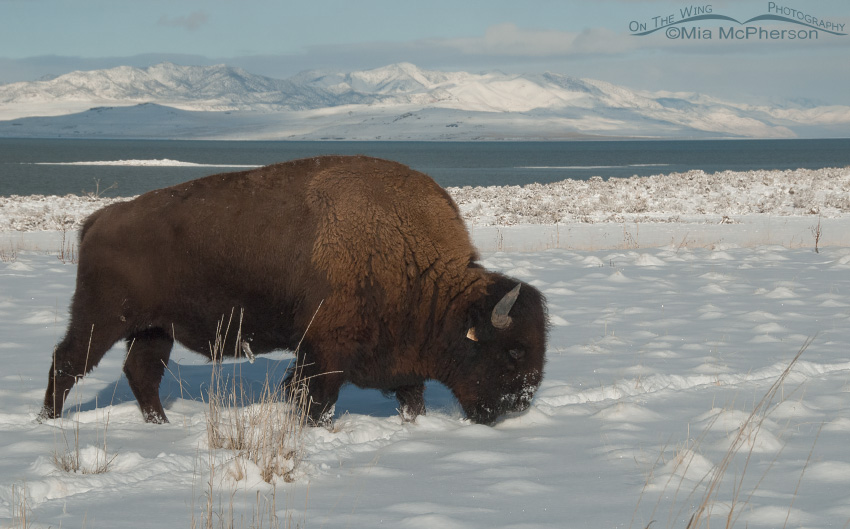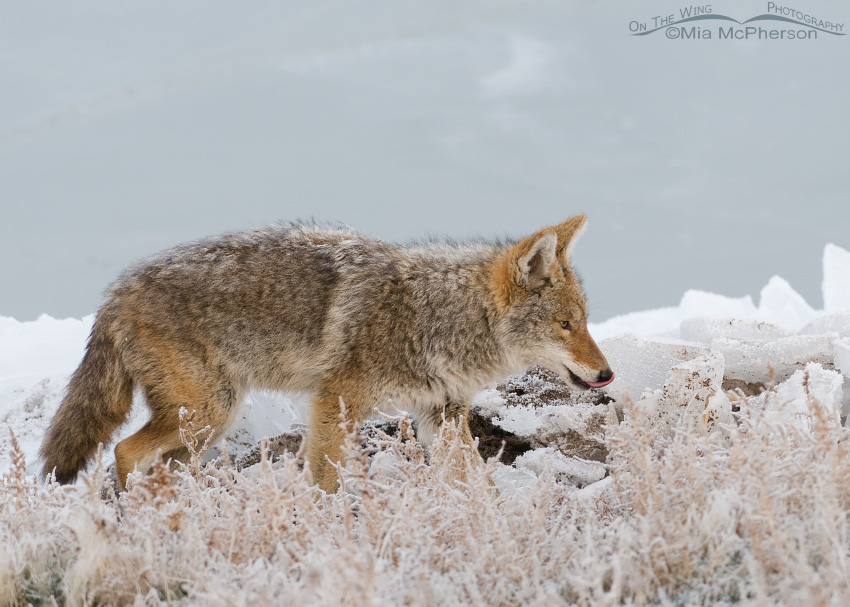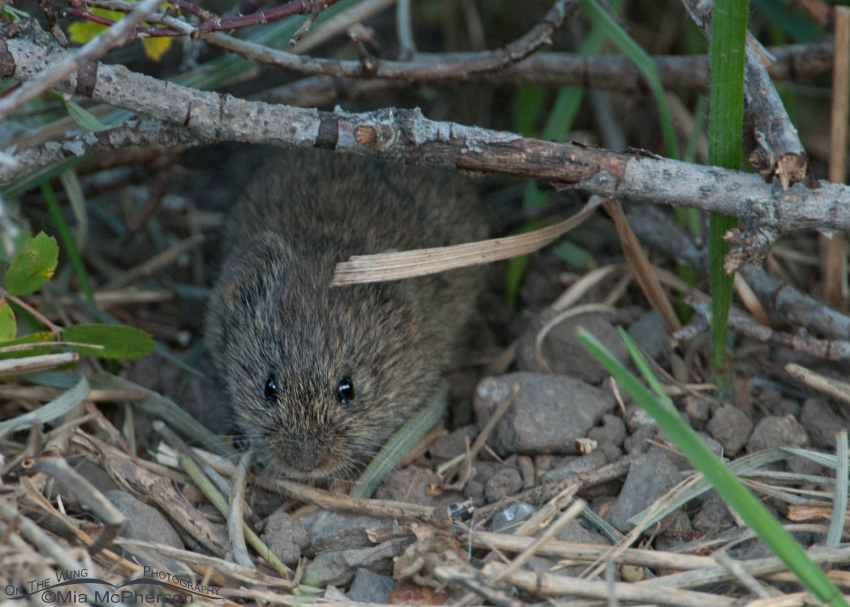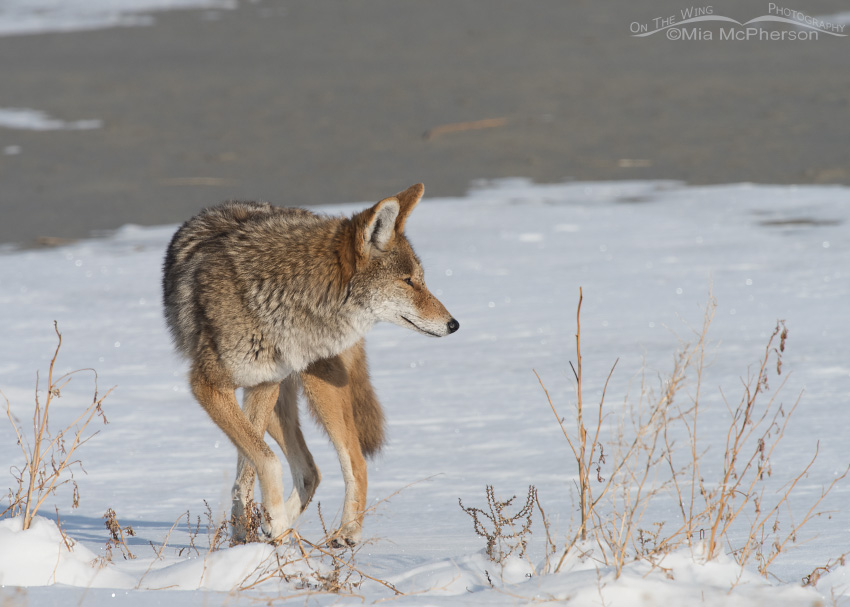 An American Bison grazing through the snow
An American Bison grazing through the snow
Yesterday the Salt Lake Tribune published an article titled “Jackrabbits are a bigger problem for cattle than bison in Utah’s Henry Mountains, USU study says” those results may have come as a surprise for some people but they didn’t surprise me. It is great though to see the results and to see the figures from the bison ecology and bison-cattle interactions that researcher Dustin Ranglack spent two years conducting in the Henry Mountains of Utah.
Eighteen genetically pure American Bison were released in the Henry Mountains in 1941 and the herd has grown to about 325 head during that time which isn’t all that large when I think of the 500+ bison that call Antelope Island State Park, a very small area compared to the Henry Mountains. The bison on Antelope Island don’t compete with cattle for food but in the Henry Mountains they do and that has caused a stir because ranchers see the bison as a big problem.
 Resting Black-tailed Jackrabbit
Resting Black-tailed Jackrabbit
The study in the Henry Mountains determined cattle consumed 52.3 percent of the grass biomass removed by herbivores in the study area. Lagomorphs — hares, rabbits and pikas — took out another 34.1 percent.
Bison accounted for 13.7 percent of the grass consumption.
So it seems that bison aren’t the problem for ranchers and their cattle, lagomorphs are.
 A Coyote after finishing off a vole
A Coyote after finishing off a vole
Coyotes in the state of Utah have a $50.00 bounty on their heads which is a foolish, non-scientific program that is supposed to save the mule deer population (I wish you could see me roll my eyes) by exterminating the coyotes in the state.
Sure, coyotes might take weak or very young mule deer but their primary prey is smaller mammals like rabbits and voles. Voles and rabbit populations are cyclic and populations explode and collapse but coyotes have historically kept those population in natural balance. Not now though because coyotes have that bounty on their heads. So is it any surprise that rabbit, hare and vole populations explode and that in the Henry Mountains their numbers are so large that they consume 34% of the grass biomass? I wonder what studies in other areas where cattle range would show?
 A vole at Cliff Lake, Montana
A vole at Cliff Lake, Montana
I have written about voles, coyotes, other natural predators and nature’s balance before so reading that there is a rabbit problem isn’t news to me because in the state of Utah “predator control” isn’t based on science at all. It is more about killing for killing’s sake and to hell with the consequences.
So the problem with ranching in the Henry Mountains isn’t the bison but rabbits and hares whose populations could be reduced substantially…
 A Coyote hunting near the Great Salt Lake
A Coyote hunting near the Great Salt Lake
By not killing the Coyotes. By using science to create a natural balance and the resulting trophic cascades that would increase biodiversity. By using our heads instead of relying on methods that have NOT worked in over 100 years.
This isn’t just just a Henry Mountain Range issue, it is a Utah issue. It is an issue where ever there are Coyotes, cattle, rabbits, hares and voles.
I need to thank Dustin Ranglack for bringing this information to light.
Mia
See how Wolves Change Rivers in this video. Granted the producer called elk deer and they show a European Badger instead of an American Badger but this video is powerful.
Read more on the study here: Bison vs. rabbits: the need for science-based management decisions in livestock–wildlife conflicts


Similar issues prevail here too. Everywhere where people put wringing the last possible resource from the land for our benefit I think. And don’t get me started on the concept of killing things as a sport. Sometimes (often) I despair.
Yes it’s all about that “natural balance” if we didn’t screw it all up nature would be doing just fine. They are not the problem to be solved but us humans.
Wonderful post and images — good work Mia. I share Neil’s concern and second Susan’s thoughts on the need for wolves and cougars to keep the coyotes in balance with the jackrabbits. In short, the balance of nature works great when man will allow it. Sadly we only see that in the wilderness areas.
Utahbooklover, it is sad that we only see natural balance in the wilderness areas and sometimes that means deep into the wilderness.
It’s an interesting study for sure Mia. I just hope this doesn’t further promote the needless and unregulated shooting of Jackrabbits, which is already a problem as they are not considered “game animals” and thus have no bag limit. Jackrabbit populations in many areas are suffering (Utah’s West Desert), and they are the preferred prey for Golden Eagles. If Jackrabbit populations decline, so do Eagle populations. Additionally, shooting Jackrabbits with lead-based ammunition and leaving them in the field can expose scavengers (including Eagles) to lead poisoning. I hope this study isn’t twisted in the wrong way to encourage more of this…
Neil, I also hope this doesn’t further promote the needless killing of Jackrabbits instead I hope that more people will pay attention to the absolute necessity of having a natural balance and allowing, sorry for the cliche, nature to take its course.
But there is no telling how the rule makers in Utah will take this study or what if any action they will take. Having dealt with the Utah Wildlife Board on the crow hunt it is easy to see why some of the board members will always vote on the side that isn’t science based. One of the most ignorant things I heard at that meeting, or even in 2014, was board member John Bair saying “We have wildlife in Utah because we hunt wildlife in Utah”. You can hear it at about 1 hour 56 minutes into this July 14, 2014 meeting
Forget the fact that there was wildlife in Utah before the pioneers arrived, forget the fact that not every species of wildlife is hunted and please just forget the fact that there was a natural balance prior to the pioneers first inhabiting Utah. It must be so because one ill-informed jackass of a board member says it?
It should be mandated that the most recent and most relevant scientific studies are used when considering hunting predators and killing non-game species for diversity and for the health of the environment.
Amen to everything Susan Stone said….it’s just common sense (well, maybe NOT so COMMON any more). It almost seems that the less common sense you have, the less you are tuned into nature’s balance, the more power and influence you have re:decisions about “managing” our environment and its doomed inhabitants (in favor of those who, in ignorance and greed, wish only to exploit it). So destructive, so sad!!!
Patty, here in Utah we need more legislators and wildlife board members who put science first.
I have never figured out why people don’t like coyotes (and therefore do everything possible to kill them – similar problem with wolves). In my experience, living in the foothills of the San Gabriel Mountains in So. California, the reason coyotes are often a problem to humans is that humans steal their territories and then complain when the coyotes do what they must, to survive. Ditto for mountain lions. I’m really tired of human arrogance and stupidity, and this post is a good reminder of how stupid and arrogant many people are. I did not check the video, but the subject reminds me of something I heard about how the reintroduction of wolves to Yellowstone National Park changed the ecology in an amazingly positive way. Long live the wolves and coyotes!
Susan, I can’t figure out why many people hate coyotes either. Or wolves and mountain lions. We keep encroaching and wildlife continues to suffer.
Mia … a very well presented, very well thought out argument against a practice that bothers the heck out of me. Take the guns out of these guys and hand ’em a golf club or a flippin’ bowling ball for crying out loud. Boys will be boys and they love their toys … do what we do with naughty puppies. Substitute the dang toy. I’m sorry, but I feel strongly about this. You can delete this, if you like, lol. Great, great pics as always. I’ll be tweeting.
Lois, I won’t delete this.
I believe that science needs to prevail. Not ignorance, superstition or blindness to the facts.